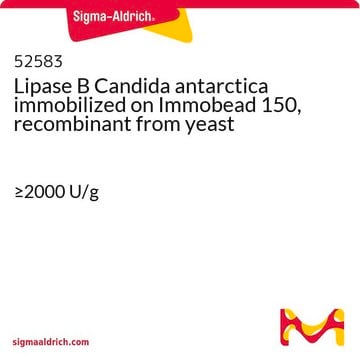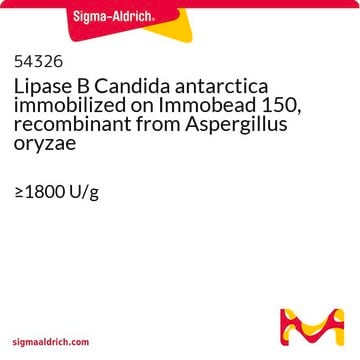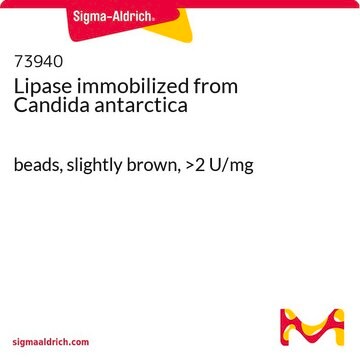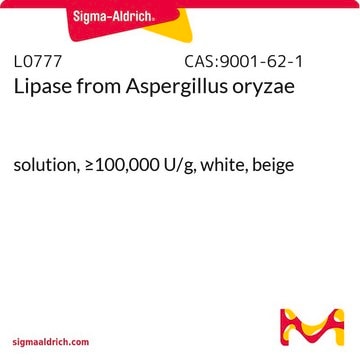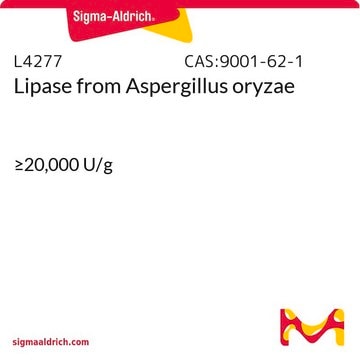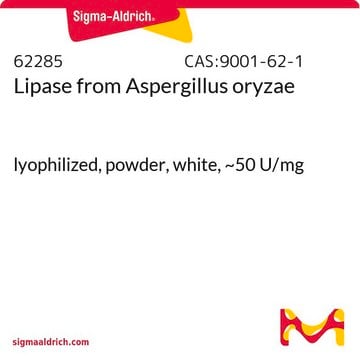When reconstituted in 50 mM Tris-HCl, pH 8.0, the solution is stable for at least one month at 2–8 °C. Similar stability would be expected with other buffers at the appropriate pH.
62288
Lipase B Candida antarctica, recombinant from Aspergillus oryzae
powder, beige, ~9 U/mg
About This Item
Recommended Products
recombinant
expressed in Aspergillus oryzae
Quality Level
form
powder
specific activity
~9 U/mg
mol wt
33 kDa
color
beige
storage temp.
2-8°C
InChI
1S/C11H9N3O2.Na/c15-8-4-5-9(10(16)7-8)13-14-11-3-1-2-6-12-11;/h1-7,16H,(H,12,14);/q;+1/b13-9-;
InChI key
QWZUIMCIEOCSJF-CHHCPSLASA-N
Looking for similar products? Visit Product Comparison Guide
General description
Application
- as a standard to characterize the enzymatic properties of D5-CalB[3]
- as an efficient biocatalyst to start the reaction to obtain (R)-ester via esterification of racemic secondary alcohol[4]
- to investigate a “green” recycling route for polybutylene succinate (PBS) based on reactive extrusion[5]
- to compare the esterification yield with adsorbed CaLB (aCaLB) and covalently immobilized CaLB (cCaLB)[6]
Biochem/physiol Actions
Candida antarctica lipase B (CALB) possesses wide substrate specificity, high activity and high enantioselectivity, hence it is considered as a major enzyme in biotechnology. It also has the capability to perform in aqueous and non-aqueous reaction environments. CALB is used in transesterification, kinetic resolution and polymerization reactions.[2]
Unit Definition
Signal Word
Danger
Hazard Statements
Precautionary Statements
Hazard Classifications
Resp. Sens. 1
Storage Class Code
11 - Combustible Solids
WGK
WGK 1
Flash Point(F)
Not applicable
Flash Point(C)
Not applicable
Personal Protective Equipment
Choose from one of the most recent versions:
Certificates of Analysis (COA)
Don't see the Right Version?
If you require a particular version, you can look up a specific certificate by the Lot or Batch number.
Already Own This Product?
Find documentation for the products that you have recently purchased in the Document Library.
Customers Also Viewed
-
After dissolution of Lipase B in 0.05M potassium phosphate buffer (pH=7.5), at what temperature should it be stored?
1 answer-
Helpful?
-
-
How pure is Product 62288, Lipase B Candida antarctica, recombinant from Aspergillus oryzae?
1 answer-
Purity is not determined for this product. As is the case with many of our enzymes, the product is assayed for enzymatic activity, not for purity.
Helpful?
-
-
What solvent can Lipase B Candida antarctica, recombinant from Aspergillus oryzae, Product 62288, be dissolved in?
1 answer-
Lipase B is expected to be soluble in water. We are able to dissolve the enzyme in water for the enzymatic assay. We also have tested the solubility of Lipase B in 0.05M potassium phosphate buffer solution (pH=7.5) during quality control at a concentration of 10mg/mL. According to the chemicals encyclopedia published by the Royal Society of Chemistry, almost all organic solvents decrease lipase activity, with the exception of petroleum ether.
Helpful?
-
-
Is Product 62288, Lipase B Candida antarctica, recombinant from Aspergillus oryzae, lyophilized?
1 answer-
This lipase is a lyophilisate and may contain Gum arabic for adjustment of activity. The amount of Gum arabic in each vial is lot dependent.
Helpful?
-
-
What is Product 62288, Lipase B Candida antarctica, recombinant from Aspergillus oryzae, soluble in?
1 answer-
Lipase B is expected to be soluble in water. We are able to dissolve the enzyme in water for the enzymatic assay. We also have tested the solubility of Lipase B in 0.05 M potassium phosphate buffer solution (pH=7.5) during quality control at a concentration of 10 mg/mL. According to the chemicals encyclopedia published by the Royal Society of Chemistry, almost all organic solvents decrease lipase activity, with the exception of petroleum ether.
Helpful?
-
-
What is the molecular weight of Lipase B Candida antarctica, recombinant from Aspergillus oryzae, Product 62288?
1 answer-
Unfortunately, molecular weight information is unavailable at this time.
Helpful?
-
-
What is the Department of Transportation shipping information for this product?
1 answer-
Transportation information can be found in Section 14 of the product's (M)SDS.To access the shipping information for this material, use the link on the product detail page for the product.
Helpful?
-
Active Filters
Our team of scientists has experience in all areas of research including Life Science, Material Science, Chemical Synthesis, Chromatography, Analytical and many others.
Contact Technical Service